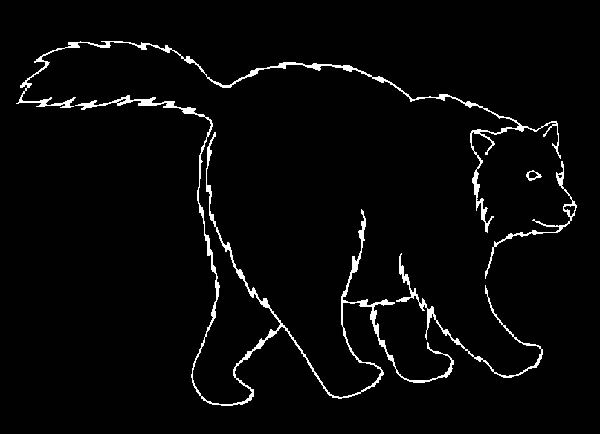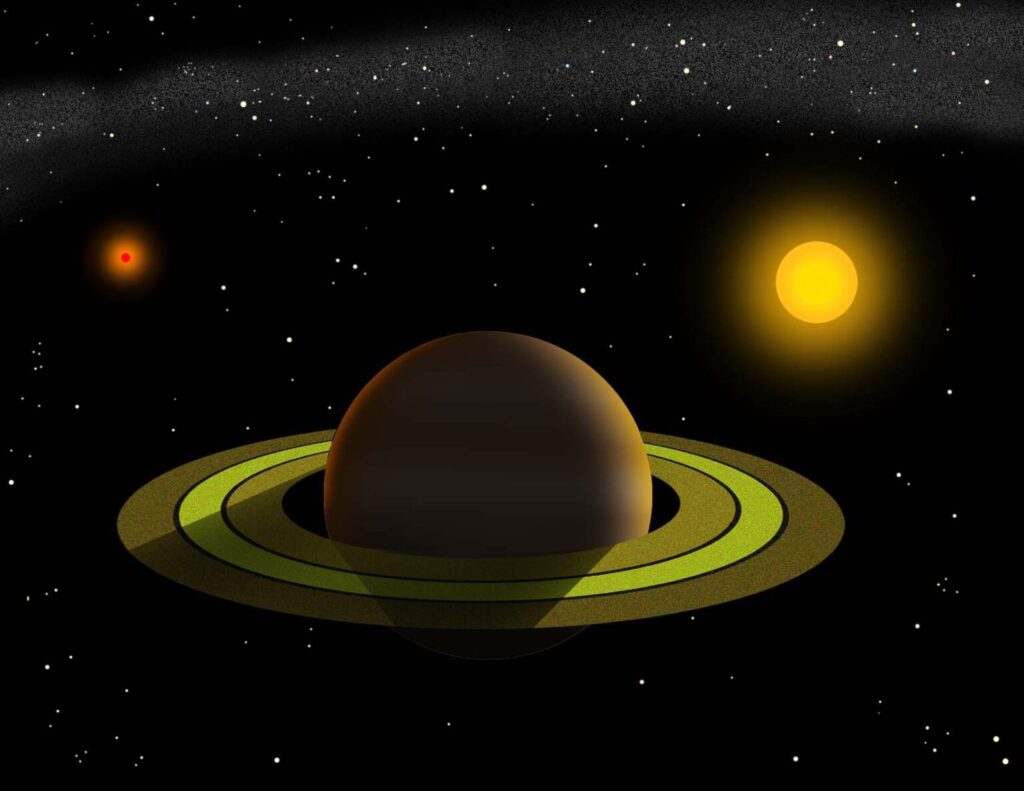Stars With Planets
In our planetarium sky, there are a couple of stars that have giant-size planets orbiting them, but with Mars-like orbits—farther out from their stars than Earth is from the Sun. They are not hot Jupiters. Are they strange planets?
You can see one of those stars year-round in the constellation of Cepheus.
To find Cepheus, let’s start with a more familiar group of stars.
Have you ever seen the Big Dipper before?
Can anyone point it out for us?
[Take any answers.]
It has seven bright stars, shaped like a pot with a long curving handle.
VISUAL 9 (optional still): Pot outline on the dipper stars [Fade on an outline of the Big Dipper “pot” shape.] There it is! Some people think of it as part of a giant ferocious bear.

DIGITAL EFFECT (optional still): Bear outline

DIGITAL EFFECTS for locating Cepheus:
Stick Big Dipper
Locate Polaris
Locate Alrai
Stick Cepheus
Cepheus
End Cepheus
The Big Dipper can be used to point to the North Star.
See these two stars?
[Indicate the Pointer Stars.]
They’re called the Pointer Stars because they point to the North Star, also called Polaris.
It’s always in exactly the same spot in the north.
If you can find the North Star, you’ll never get lost.
Follow the pointer stars to Polaris, and indicate.
Here’s the North Star! And if you keep going a little farther…
[Continue to Cepheus.]
You’ll find this bright star.
[Point to Gamma Cephei (Alrai).]
That star is in the constellation Cepheus, the King.
The star called Gamma Cephei, which means “third-brightest-in-Cepheus.”
Its Arabic name is Alrai (a.k.a. Errai, or Er Rai).
It is 45 light-years away, and is a binary star system: two stars revolving around one another every 50 years or so.
Imagine having 2 suns in your sky!
A strange planet indeed.
[Play music.]
VISUAL 10 (still): Planet with two suns
[A binary star system with planet.]

Optional: Hand out Uncle Al’s Kepler Star Wheels (see master), have the audience set them for May 25 at 10 pm, and find Alrai (Gamma Cephei) on the star wheel. Explain how to adjust the Star Wheel, and let them know that you’ll be telling them how to get their own copy to make from a web page that you’ll give them.
The planet is bigger than Jupiter, about 1.5 times Jupiter’s mass, and is going around the larger star of the binary system. It’s year is 2½ Earth years, and a tad bit farther from it’s sun than our Mars is from our Sun.
[Fade off image of planet with two suns.]
Another star with a planet can be found in this very famous winter constellation, Gemini.
DIGITAL EFFECTS:
Gemini [Show artwork of Gemini outline.]
Stick Gemini [Show only a stick figure of Gemini.]
Point out Gemini, with outline.
Fade music.
The brightest star in Gemini is this one, Pollux.
[Point to and show label.]
DIGITAL EFFECT: Locate Pollux
Place an arrow on the dome to point out the position of Pollux.
It’s 34 light-years away, and the brightest star known to have an extrasolar planet.
The planet is even bigger than Alrai’s—more than twice the mass of Jupiter—and orbits in about 590 days, which is similar to Mars in our solar system. You can see this star from about October (around midnight) through June (just after sunset). Is this a strange planet? Well, Pollux is an orange giant star, evolving into its red giant stage. So yes, you might call this a strange planet with an orange giant sun. Once Pollux is fully evolved into a red giant, it may have grown to a size so big that it will engulf this planet!
VISUAL 11 (still): Sun, Orange Giant, Red Giant size comparison

Optional: Find Pollux on Uncle Al’s Kepler Star Wheels.
[Fade off the red giant size comparison image.]
DIGITAL EFFECT: Exoplanets
Fade on exoplanet markers, and add some diurnal motion for dramatic effect. For full-dome digital systems, show exoplanets. Explain that we have marked stars that have at least one exoplanet confirmed. After a stop, fade off the exoplanets or exoplanet markers.

